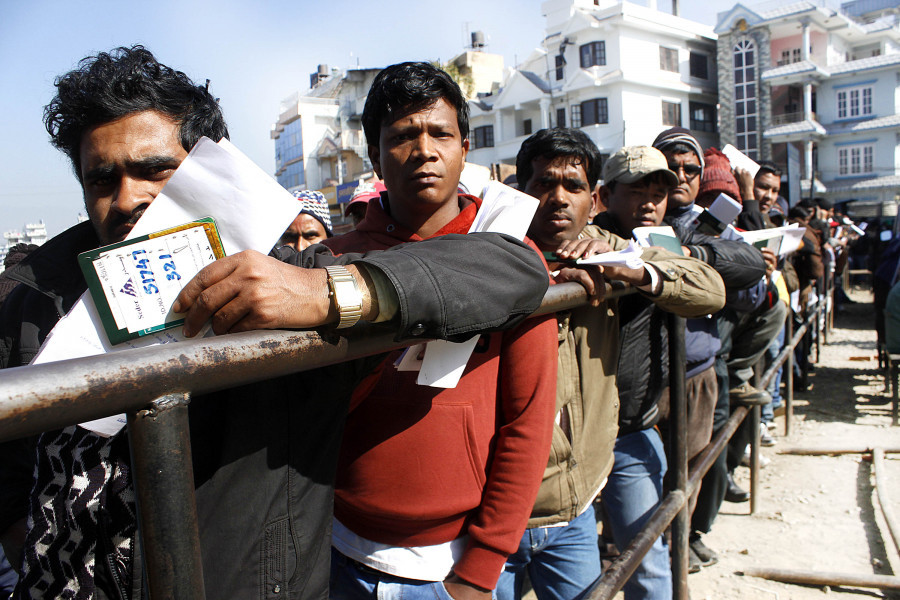Columns
Mismatches in labour market
Nepal is entering a new phase of industrial practices in line with global trends.
Achyut Wagle
In addition to difficulties in mobilising financial resources, Nepal’s industrial sector is now facing an acute shortage of skilled and semiskilled labourers. The situation in the agricultural sector which contributes 23.9 percent to the gross domestic product is no different. According to private employers, the shortage has pushed up wages to unfeasible levels, forcing them to hire migrant workers from neighbouring countries.
The Nepal Labour Force Participation Rate, a measure of the proportion of a country’s working-age population actively engaged in work or looking for a job, is estimated to be 40.8 percent. By this measure, considering Nepal’s current population of 29.2 million, the number of people available in the labour force is expected to be 11.91 million. When this figure is compared with the country’s population pyramid, the active working-age population between the ages of 20-64 years is 53.2 percent or 15.53 million. The difference, representing the active age population which is not yet part of the country’s labour force, is 3.62 million. This is either disguised unemployment or emigration to foreign countries for employment.
Labour migration
A World Bank study on labour migration shows that approximately 2.69 million Nepalis work abroad, including 733,000 in India. As per the latest data released by Nepal Rastra Bank, the central bank, the number of workers that left the country during the first eight months of the current fiscal year (till mid-March) is 544,230; out of which 351,761 took new approvals and 192,559 renewed their old permits to work abroad.
According to World Bank data, 12.2 percent or 2.06 million (out of 16.93 million) Nepali people between the ages of 15-64 years are unemployed. The partially employed population is estimated to be 21 percent. The number of Nepalis migrating to third countries without a formal work approval, seasonal migrant workers going to India, and youths leaving for higher studies abroad is also significant.
Gender and geographical dimensions that constrain participation in the labour force also substantially reduce the net number of actual working people. The No Objection Certificate (NOC) section of the Ministry of Education, Science and Technology issued 117,563 NOCs to Nepali students to study abroad during the last nine months of the current fiscal year, providing another example of how the workforce is being drained.
Also, the data of the Bilateral Migration Matrix largely substantiates the claim of Nepali industrialists that they are forced to rely heavily on foreign workers to keep their factories and businesses running. In 2021, for example, 487,564 foreign migrant workers came to work in Nepal. Among them were 426,941 Indians, 27,502 Bhutanese and 19,428 Chinese. They sent home $1.7 billion in remittance in the same year.
The mismatches
Despite the exodus of Nepali working-age youths, a back-of-the-envelope calculation indicates that at least 1 million to 1.5 million persons should have been available in the domestic labour market. The number of applicants to the government’s funding schemes like the Prime Minister Self-Employment Programme and Youth and Small Entrepreneur Self-Employment Fund reaches hundreds of thousands each year. These hopefuls should offset the demand for foreign workers, but that doesn’t appear to be happening.
The first reason is skills mismatch, the difference between the skills sought by the productivity and profit-oriented private sector and the presence of these skills in potential employees. Nepal’s academic and vocational training ecosystem has failed to produce mid-level managers and semi-skilled workers. Even marginally trained workers leave the country not only for better pay, but also due to peer pressure to work abroad despite comparable salaries in many technical sectors at home.
Second, Nepali employers do not seem to possess honest intentions to hire Nepali workers. One of the main deterrents is the compulsory social security contribution that employers have to shoulder after hiring a Nepali worker. Equally repelling is the pervasiveness of politically protected trade union organisations and their aggressiveness. So employers prefer to hire easily available foreign, mainly Indian, employees who may also possess better technical or professional skills on contract basis without any additional or long-term liabilities.
Third, Nepal is entering a new phase of industrial practices akin to global trends and practices. This is creating demand for workers with a new set of skills. For example, the Nepali private sector has invested heavily in hydropower projects which needs specially trained manpower for civil, electrical and transmission line engineering works. Every single task these days is integrated or related to knowledge of information and communication technology, digitisation and automation, but there are very few institutions dedicated to producing quality manpower in the field. New and emerging approaches to green, sustainable and socially responsible business and production practices warrant a systematic exposure of workers in these areas.
Nepal’s education system is marred by policy confusions and appears to be completely indifferent to the demand-supply paradigm of the Nepali labour market. Only a small section of society has access to technical and vocational training. Instead of gradually increasing the number of these institutions, the existing ones are being rendered dysfunctional or liquidated.
Another inconsistency is between the formal degrees awarded by academic institutions and the skills possessed by the degree holders. The higher education institutions which are producing unemployable degree holders do not admit their failures. As government policies and private sector practices do not ensure employment upon completion of education, labour market mismatches in multiple dimensions are growing. In light of the rapidly changing demographic and technological dynamics, a coherent approach by academia and the public and private sectors is needed to map out labour, wage and economic outputs instead of the blame game and self-obsessed practices.



 13.12°C Kathmandu
13.12°C Kathmandu















